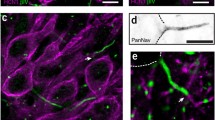Summary
Intracellular studies on photoreceptors in the eyes of the giant clamTridacna give evidence for two types of light-sensitive cells, both of which are hyperpolarized by light. These cells are distinguished by the presence or absence of spikes and corresponding characteristics of the receptor potential. In non-spiking (NS) receptors, the average resting potential in the dark is low (-15 mV) and peak receptor potentials are large (to 100 mV) and adapt rapidly to light. Spiking (S) receptors have higher average resting potentials (-45 mV), but receptor potentials do not exceed 20 mV and also do not adapt to light. The spikes in S-receptors are small (3–8 mV), occur spontaneously at low levels of illumination and are inhibited by light. Bursts of spikes arise on the repolarizing off-component of the receptor potential. Light adaptation increases the excitability of S-receptors in terms of a higher frequency and shorter latency of the off response burst. The receptor potential in both cells is due to a light-activated increase in membrane conductance to potassium ions. Membrane conductance decreases in NS-receptors in relation to light adaptation. Unlike the scallop eye, no depolarizing photoreceptors are present.
Similar content being viewed by others
Abbreviations
- NS :
-
non-spiking photoreceptors
- S :
-
spiking photoreceptors
- SW :
-
seawater
References
Barber VC, Land MF (1967) Eye of the cockle,Cardium edule: anatomical and physiological investigations. Experientia 23:677–678
Barber VC, Wright DE (1969) The fine structure of the eye and optic tentacle of the molluscCardium edule J Ultrastruct Res 26:515–528
Barber VC, Evans E, Land MF (1967) The fine structure of the eye of the molluscPecten maximus. Z Zellforsch 76:295–312
Cornwall MC, Gorman ALF (1979) Contribution of calcium and potassium permeability changes to the off response of scallop hyperpolarizing photoreceptors. J Physiol 291:207–232
Cornwall MC, Gorman ALF (1983) The cation selectivity and voltage dependence of the light-activated potassium conductance in scallop distal photoreceptor. J Physiol 340:287–305
Fankboner PV (1981) Siphonal eyes of giant clams and their relationship to adjacent zooxanthellae. Veliger 23:245–249
Gorman ALF, McReynolds JS (1978) Ionic effects on the membrane potential of hyperpolarizing photoreceptors in scallop retina. J Physiol 275:345–355
Hartline HK (1938) The discharge of impulses in the optic nerve ofPecten in response to illumination of the eye. J Cell Comp Physiol 1:277–295
Järvilehto M (1979) Receptor potentials in invertebrate visual cells. In: Autrum H (ed) Vision in invertebrates. (Handbook of sensory physiology, vol VII/6A). Springer, Berlin Heidelberg New York, pp 315–356
Kawaguti S, Mabuchi K (1969) Electron microscopy on the eyes of the giant clam. Biol J Okayama Univ 15:87–100
Kennedy D (1958) Neural photosensitivity inMactra. Biol Bull 115:338
Kennedy D (1960) Neural photoreception in a lamellibranch mollusc. J Gen Physiol 44:277–299
Land MF (1968) Functional aspects of the optical and retinal organization of the mollusc eye. Symp Zool Soc Lond 23:75–96
McReynolds JS, Gorman ALF (1970) Photoreceptor potentials of opposite polarity in the eye of the scallop,Pecten irradians. J Gen Physiol 56:376–391
Miller WH (1958) Derivatives of cilia in the distal retina ofPecten. J Biophys Biochem Cytol 4:227–228
Mpitsos GJ (1973) Physiology of vision in the molluskLima scabra. J Neurophysiol 36:371–383
Oland LA, French KA, Hayashi JH, Stuart AE (1983) Lateral visual pathway of giant barnacle. J Neurophysiol 49:516–527
Shaw SR (1972) Decremental conduction of the visual signal in barnacle lateral eye. J Physiol 220:145–175
Spagnolia T, Wilkens LA (1983) Neurobiology of the scallop. II. Structure of parietovisceral ganglion lateral lobes in relation to afferent projections from the mantle eyes. Mar Behav Physiol 10:23–55
Stasek CR (1962) The form, growth and evolution of the Tridacnidae (Giant clams). Arch Zool Exp Gen 101:1–40
Stasek CR (1965) Behavioral adaptation of the giant clamTridacna maxima to the presence of grazing fishes. Veliger 8:29–35
Stewart WW (1978) Functional connections between cells as revealed by dye-coupling with highly fluorescent naphthalimide tracer. Cell 14:741–759
Trench RK, Wethey DS, Porter JW (1981) Observations on the symbiosis with zooxanthellae among the Tridacnidae (Mollusca, Bivalvia). Biol Bull 161:180–198
Wiederhold ML, MacNichol EF Jr, Bell AL (1973) Photoreceptor spike responses in the hardshell clam,Mercenaria mercenaria. J Gen Physiol 61:24–55
Wilkens LA (1972) Electrophysiological studies on the heart of the bivalve mollusc,Modiolus demissus. I. Ionic basis of the membrane potential. J Exp Biol 56:273–291
Wilkens LA (1984) Ultraviolet sensitivity in hyperpolarizing photoreceptors of the giant clamTridacna. Nature 309:446–448
Wilkens LA (1986) The visual system of the giant clamTridacna: behavioral adaptations. Biol Bull 170:393–408
Yonge CM (1980) Functional morphology and evolution in the Tridacnidae (Mollusca: Bivalvia: Cardiacea). Rec Aust Mus 33:735–777
Author information
Authors and Affiliations
Rights and permissions
About this article
Cite this article
Wilkens, L.A. Hyperpolarizing photoreceptors in the eyes of the giant clamTridacna: physiological evidence for both spiking and nonspiking cell types. J. Comp. Physiol. 163, 73–84 (1988). https://doi.org/10.1007/BF00611998
Accepted:
Issue Date:
DOI: https://doi.org/10.1007/BF00611998




